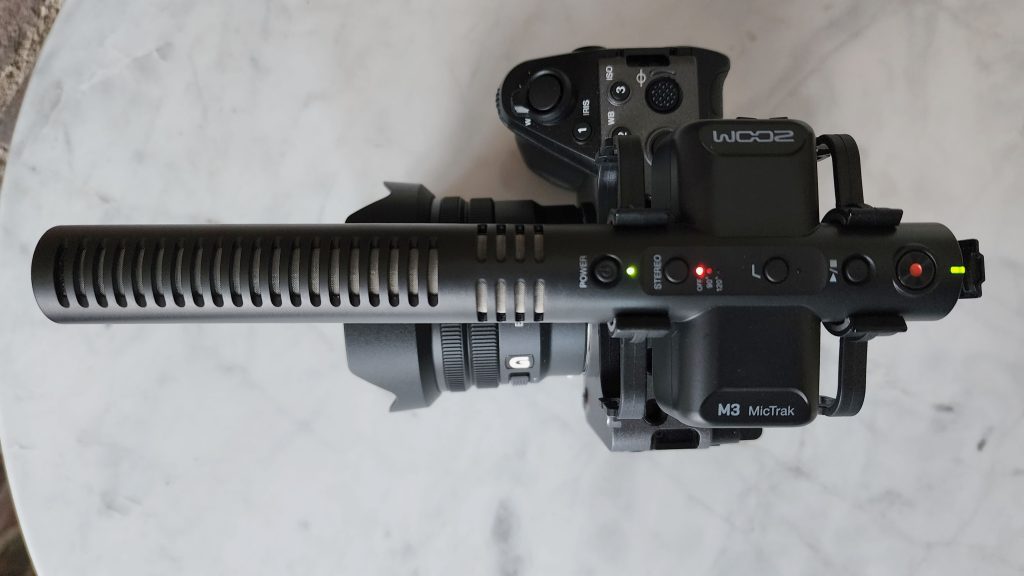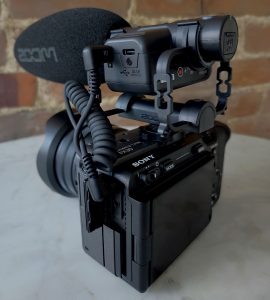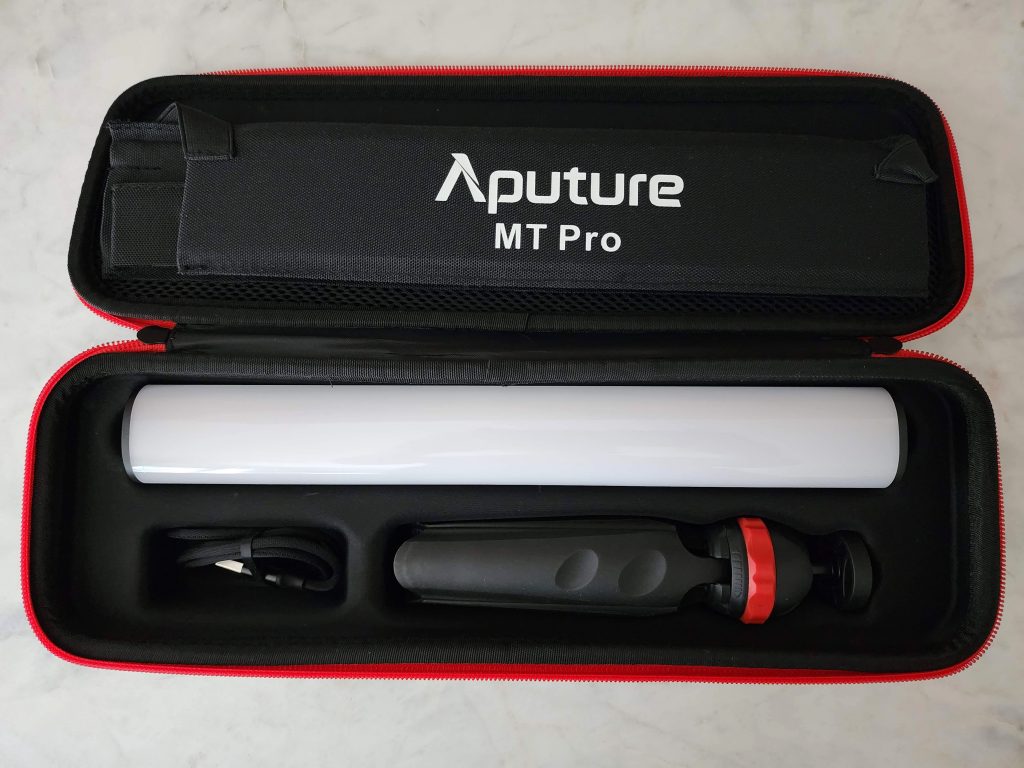It’s hard to keep up with the portable continuous light industry, as they launch brighter outputs, lower price points, more versatility, and in the case of Aputure’s new Amaran 200x S, better color accuracy (and slightly higher output at the indoor color temperature) compared to their preceding budget workhorse 200x (without the S). We’ve lately seen novice-brand companies like SmallRig and Zhiyun try to enter the game, but their products fall short. I’ve previously at this blog reviewed, besides Aputure’s ultra-portable lights and tubes, Sokani monolights starting with their X60 RGB full-color-spectrum model, and then their brighter X100 bi-color model, paired with suggested accessories that pragmatically combine into an ideal full-service lighting kit for creators on a budget. In that spirit, let’s do the same for the new Amaran, which outperforms them all for a still-reasonable $349 USD.
 So, what’s new about the 200x S (like, what does that -S suffix mean compared to the prior 200x)? One gets the impression, it’s best kept simply explained, sparing the engineering details: that you get “an 18.6% increase in SSI from its predecessor,” which is a rating of color accuracy and a fuller metric than the CRI we most often see on cheaper products. The upgraded “dual-blue LED chipset” seen at left makes the light that it produces closer to reality than usual for LED lights, compared to authentic daylight (outdoor) or tungsten (traditional indoor) color sources. In the real world, this mainly translates into more believable skin tones, instead of getting creepy shades of greens, oranges and blues. One additional feature of the new LED chipset is slightly higher luminance (brightness) at the lower (indoor) color temperature compared to the prior 200x without the -S, while actually drawing a little less power too.
So, what’s new about the 200x S (like, what does that -S suffix mean compared to the prior 200x)? One gets the impression, it’s best kept simply explained, sparing the engineering details: that you get “an 18.6% increase in SSI from its predecessor,” which is a rating of color accuracy and a fuller metric than the CRI we most often see on cheaper products. The upgraded “dual-blue LED chipset” seen at left makes the light that it produces closer to reality than usual for LED lights, compared to authentic daylight (outdoor) or tungsten (traditional indoor) color sources. In the real world, this mainly translates into more believable skin tones, instead of getting creepy shades of greens, oranges and blues. One additional feature of the new LED chipset is slightly higher luminance (brightness) at the lower (indoor) color temperature compared to the prior 200x without the -S, while actually drawing a little less power too.
 Speaking of color temperature, another thing worth mentioning is the overall future of artificial lighting (a term used in contrast to “practical” lighting which includes natural sources like the sun, or existing sources like table lamps using standard light bulbs). I was at CineGear Expo a few weeks ago and chatted with an Aputure rep about how their RGB LED light panels, such as the new P60c seen at right, includes a hue dial mode in addition to the CCT color temperature dial mode. In other words, even for the purpose of only achieving accurate white balance, rather than splashing the whole rainbow spectrum of theatrical lighting, it is inevitable someday that all lighting kits should give us the power to tweak/bias hue too. We all know this from the experience of color grading for white balance in NLE applications like Adobe Premiere: there’s a slider for Temperature (between blue and orange), and a slider for Tint (between green and red). Taking just one example: if I’m trying to achieve accurate white balance, but my subject’s skin is surrounded by green vegetation/leaves, a bi-color monolight like the 200x S won’t be enough — and shifting the hue into the red direction, away from green, would become priceless if possible. But as I discovered from the Sokani X60 RGB monolight, the full color spectrum capability comes at the expense of luminance/output power, and CCT accuracy. It’s currently a trade-off. What this 200x S delivers, then, is maximum power at the typical drawback of sticking to the workhorse CCT spectrum only — and it could be worse, when using the sibling 200d S, which limits you to daylight color temperature only.
Speaking of color temperature, another thing worth mentioning is the overall future of artificial lighting (a term used in contrast to “practical” lighting which includes natural sources like the sun, or existing sources like table lamps using standard light bulbs). I was at CineGear Expo a few weeks ago and chatted with an Aputure rep about how their RGB LED light panels, such as the new P60c seen at right, includes a hue dial mode in addition to the CCT color temperature dial mode. In other words, even for the purpose of only achieving accurate white balance, rather than splashing the whole rainbow spectrum of theatrical lighting, it is inevitable someday that all lighting kits should give us the power to tweak/bias hue too. We all know this from the experience of color grading for white balance in NLE applications like Adobe Premiere: there’s a slider for Temperature (between blue and orange), and a slider for Tint (between green and red). Taking just one example: if I’m trying to achieve accurate white balance, but my subject’s skin is surrounded by green vegetation/leaves, a bi-color monolight like the 200x S won’t be enough — and shifting the hue into the red direction, away from green, would become priceless if possible. But as I discovered from the Sokani X60 RGB monolight, the full color spectrum capability comes at the expense of luminance/output power, and CCT accuracy. It’s currently a trade-off. What this 200x S delivers, then, is maximum power at the typical drawback of sticking to the workhorse CCT spectrum only — and it could be worse, when using the sibling 200d S, which limits you to daylight color temperature only.
 200 watts is indeed a lot of power (that’s what the 200x stands for — you can get a 100x S for a hundred bucks less, if you’re pinching pennies, though double the brightness latitude at that same size seems worth it to me, since you can always dial down the brightness, as seen in the above pictures that show one dial for CCT or color temperature, and the other for INT or intensity). So unless you want to haul around an unwieldy gigantic battery module, you’re going to need an AC wall outlet. Compared to most other monolights, I really like how Aputure designed a bright yellow, solid connector interface angled to where you’re reaching up, adjacent to a similarly angled power toggle. As seen in the picture at right, I also like how the external power supply includes a metallic loop that you can use to sling onto the stand, in case cables don’t fully reach the ground, etc. On the back panel display, it couldn’t be simpler: you get the intensity percentage, and the color temperature in Kelvin, with a Bluetooth logo indicating connection to Aputure’s free Sidius Link app that you can download for free to Android or iOS smartphones/tablets. (But, ugh: note to engineers, we search for apps alphabetically on our phones, so please for the love of God just start off app names with your company names! Why should I remember the word “Sidius” in a sea of hundreds of apps?)
200 watts is indeed a lot of power (that’s what the 200x stands for — you can get a 100x S for a hundred bucks less, if you’re pinching pennies, though double the brightness latitude at that same size seems worth it to me, since you can always dial down the brightness, as seen in the above pictures that show one dial for CCT or color temperature, and the other for INT or intensity). So unless you want to haul around an unwieldy gigantic battery module, you’re going to need an AC wall outlet. Compared to most other monolights, I really like how Aputure designed a bright yellow, solid connector interface angled to where you’re reaching up, adjacent to a similarly angled power toggle. As seen in the picture at right, I also like how the external power supply includes a metallic loop that you can use to sling onto the stand, in case cables don’t fully reach the ground, etc. On the back panel display, it couldn’t be simpler: you get the intensity percentage, and the color temperature in Kelvin, with a Bluetooth logo indicating connection to Aputure’s free Sidius Link app that you can download for free to Android or iOS smartphones/tablets. (But, ugh: note to engineers, we search for apps alphabetically on our phones, so please for the love of God just start off app names with your company names! Why should I remember the word “Sidius” in a sea of hundreds of apps?)
Another nice touch is the way that the included power cord that runs from the brick transformer, to an AC wall outlet, locks in with a red tab/switch (just like the power cord into the light locks into its yellow receptacle), ensuring that nothing yanks loose during a shoot. Unfortunately though, compared to the Sokani products and many others, Aputure does not include any bag to carry these several accessories. Worse, they don’t sell one or recommend one, thus you’re on your own finding something that carries the monolight, power supply, and detached Bowens-mount “Hyper Reflector” which kicks up the output from 6400 lux to 45,400 lux.
But that reflector casts a harsh circle around your target (even more than the prior Amaran product pairings), so for almost all use cases — to avoid a stark corporate video look — you’re going to need a modifier with difffusion. I’ve got a winning favorite that I’ve touted before: the Aputure Lantern which is a bargain at $89 USD.
 This type of attachment is usually called a “China ball” on movie sets (a political incorrectness that actually just makes me giggle), not always the first choice for conventional lighting kits. They’re most classically used for overhead lighting above a roundtable discussion — one great example, exposed in many shots, is the restaurant setting in Martin Scorsese’s Netflix series Pretend It’s a City with Fran Liebowitz. But as a practical compromise, it casts a very diffuse and broad glow that minimizes shadows, compared to your next-best option such as the Aputure Light Dome Mini II which sacrifices maximum softness for a stronger and more directed cast. And it still can mount facing forward, as seen above, casting a wide berth. The Lantern instantly sets up and breaks down: you just latch one center support loop into a hook that you can see when peeking down into the bottom (in the picture at right), and those pre-installed “ribs” on the sides just warp into position. It literally takes about 5 seconds, and when collapsed, it’s nice and small, and packs into its included carrying case seen below, which in turn can fit into a bag for everything that includes a light stand.
This type of attachment is usually called a “China ball” on movie sets (a political incorrectness that actually just makes me giggle), not always the first choice for conventional lighting kits. They’re most classically used for overhead lighting above a roundtable discussion — one great example, exposed in many shots, is the restaurant setting in Martin Scorsese’s Netflix series Pretend It’s a City with Fran Liebowitz. But as a practical compromise, it casts a very diffuse and broad glow that minimizes shadows, compared to your next-best option such as the Aputure Light Dome Mini II which sacrifices maximum softness for a stronger and more directed cast. And it still can mount facing forward, as seen above, casting a wide berth. The Lantern instantly sets up and breaks down: you just latch one center support loop into a hook that you can see when peeking down into the bottom (in the picture at right), and those pre-installed “ribs” on the sides just warp into position. It literally takes about 5 seconds, and when collapsed, it’s nice and small, and packs into its included carrying case seen below, which in turn can fit into a bag for everything that includes a light stand.
Since portability and low cost is what distinguishes these products, I found a match in the perfect lighting stand for it, manufactured by Impact and sold for as little as $100 USD. Its best feature is that it combines light stand with boom, and a mounting hole at the end so you can attach a counterweight. Impact includes a saddle bag that you can throw anything into for adding weight, such as other batteries you brought with you, or bottles of water that you’ll be drinking when you pack up anyway.
The stand has a big knob to tighten the angle that doesn’t slip, and its magic trick is that the boom arm telescopes down into the vertical light stand! So you can skip the boom part if you don’t need it, and the stand adapter at the end can point straight up.

It’s reasonably small at 45 inches collapsed, but it can get up to 13 feet. For packing everything up but keeping to a low budget, there’s also a great padded bag that fits the stand perfectly from Ruggard costing under $60 USD, way below anything else I could find. It’s perfect for holding the light stand, and also the diffuser that we’ve added to this kit.
But if you don’t need the boom arm and rock-stability of the Impact stand, and want something super light and portable, then after a lot of research and experimentation, I’ve settled on the Kupo Handy Stand for $60 USD, which folds down to an amazingly short 19.2 inches but extends to a maximum height of 89.3 inches. You might find your light swaying around nervously when you bump it, but so long as you spread the legs out fully horizontally, and point one of them in the same direction as your light, it should hold up! And then, you’d best get a smaller version of the Ruggard bag to match the smaller stand.


























